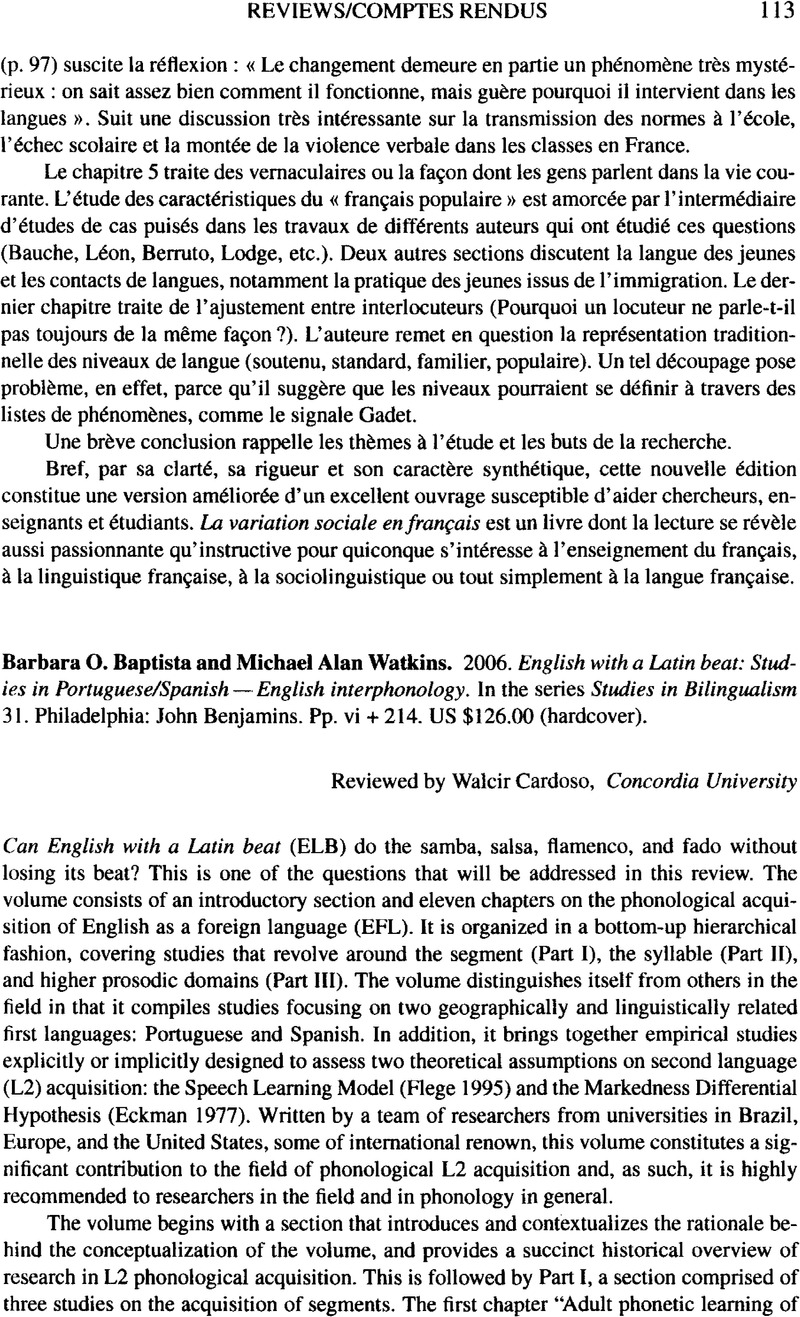No CrossRef data available.
Article contents
Barbara O. Baptista and Michael Alan Watkins. 2006. English with a Latin beat: Studies in Portuguese/Spanish — English interphonology. In the series Studies in Bilingualism 31. Philadelphia: John Benjamins. Pp. vi + 214. US $126.00 (hardcover).
Review products
Barbara O. Baptista and Michael Alan Watkins. 2006. English with a Latin beat: Studies in Portuguese/Spanish — English interphonology. In the series Studies in Bilingualism 31. Philadelphia: John Benjamins. Pp. vi + 214. US $126.00 (hardcover).
Published online by Cambridge University Press: 27 June 2016
Abstract
An abstract is not available for this content so a preview has been provided. Please use the Get access link above for information on how to access this content.

- Type
- Reviews/Comptes rendus
- Information
- Canadian Journal of Linguistics/Revue canadienne de linguistique , Volume 53 , Issue 1 , March 2008 , pp. 113 - 116
- Copyright
- Copyright © Canadian Linguistic Association/Association canadienne de linguistique 2008
References
Broselow, Ellen, and Xu, Zheng. 2004. Differential difficulty in the acquisition of second language phonology. International Journal of English Studies 4: Advances in Optimality Theory, ed. Boersma, P. and Cutillas-Espinosa, J.A., 135–163.Google Scholar
Broselow, Ellen, Chen, Su-I., and Wang, Chilin. 1998. The emergence of the unmarked in second language phonology. Studies in Second language Acquisition 20:261–280.Google Scholar
Bybee, Joan, and Hopper, Paul, eds. 2001. Frequency and the emergence of linguistic structure. Amsterdam: John Benjamins.Google Scholar
Cardoso, Walcir. 2007. The variable development of English word-final stops by Brazilian Portuguese speakers: A stochastic optimality theoretic account. Language Variation and Change 19:1–30.Google Scholar
Clements, George. 1990. The role of the sonority cycle in core syllabification. In Papers in laboratory phonology I: Between the grammar and physics of speech, ed. Kingston, John and Beckman, Mary, 283–333. New York: Cambridge University Press.Google Scholar
Eckman, Fred. 1977. Markedness and the contrastive analysis hypothesis. Language Learning 27:315–330.Google Scholar
Escudero, Paola, and Boersma, Paul. 2004. Bridging the gap between L2 speech perception research and phonological theory. Studies in Second Language Acquisition 26:551–585.Google Scholar
Flege, James Emil. 1993. Production and perception of a novel, second-language phonetic contrast. Journal of the Acoustical Society of America 93:1589–1608.Google Scholar
Flege, James Emil. 1995. Second language speech learning: Theory, findings and problems. In Speech perception and linguistic experience: Issues in cross-language research, ed. Strange, Winifred, 233–277. Timonium, MD: York Press.Google Scholar
Kucera, Henry, and Francis, Nelson. 1967. Computational analysis of present-day American English [The Brown Corpus]. Providence: Brown University Press.Google Scholar
Polivanov, Evgenij. 1931. La perception des sons d’une langue étrangère. Travaux du Cercle Linguistique de Prague 4:79–96.Google Scholar
Prince, Alan, and Smolensky, Paul. 1993. Optimality Theory: Constraint interaction in generative grammar. Cambridge, MA: MIT Press.Google Scholar


